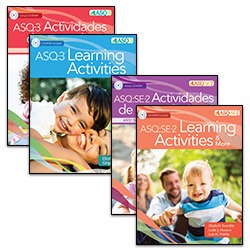
Strong and consistent partnerships between families and early childhood professionals are an important part of any successful screening program. This month, we surveyed some seasoned ASQ users to see what methods they rely on to engage and communicate with parents and family members during the screening process. In this article, we’ll highlight some of the responses we received, along with proven strategies to support three key objectives for every screening program: introducing ASQ questionnaires and addressing parent concerns, communicating results and discussing next steps, and supporting healthy development between screenings.
Introduce questionnaires and discuss concerns
Parents will be more comfortable and engaged in screening when they understand what it’s for and how it works. You’ll want to introduce them ahead of time to the concept and benefits of developmental screening, give them a clear overview of how ASQ works, and review the specifics of how to successfully complete a screening. Take time to listen to families’ questions and concerns, and frame screening in a positive way. ASQ user Jane Cohen, a program coordinator with Early Childhood Alliance, makes an important distinction: “We discuss this is not a test but as a way to see your child—what they are learning and how they grow.”
If you’re looking for specific ideas on how to set up an ASQ introduction for the parents in your program, here are some suggestions from our survey respondents:
- Hold a new families night or an open house where you can introduce ASQ to a group of families at once
- Have an orientation for each new family and introduce ASQ during the intake process
- Schedule a special “ASQ Day” in your program or classroom where parents can come in, learn about ASQ, and fill out a questionnaire right there
- Create a personalized cover letter or handout to send to families with the questionnaire, covering common questions and concerns
- Fold ASQ into a home visit and review the screening process with families during the visit
- Offer a support group where parents can learn about the how and why of screening
- Make ASQ a routine part of parent-teacher conferences, and schedule enough time to review screening basics and answer any questions
- Talk about ASQ in your program’s e-zine, newsletter, and/or social media
- Be sure that screening information is a permanent, easy-to-find part of your program’s website and parent handbook
- Record a short video introducing ASQ that you can play at a parent orientation and keep on the website
- Hold a virtual community event via Zoom or another platform to educate parents about ASQ (beyond safety reasons, this can also be helpful for families with scheduling and transportation issues)
However you choose to introduce ASQ to families, your program will notice the benefits of setting aside time for this critical conversation. Deborah Colter, director of Debbie’s Little Angels, says that as a result of that initial conversation about screening, “the parents have the opportunity to see [our] level of commitment to the families as partnerships. They become investors in their children’s progress and willing to make the learning process beneficial.”
 If a parent is hesitant about screening even after your introductory conversation, consider doing ASQ together with them. Jeanine Woltman, lead home visitor with CASE/Glenbard Early Childhood Collaborative, has embraced this approach: “We try whenever possible to conduct the screening with the parent, providing a space for them to clarify, ask questions, and better understand the tool and what it is looking for.” Filling out a questionnaire together is not only reassuring, but also a perfect opportunity for helping families learn about milestones and behaviors. “My favorite question is the one about climbing to reach something high,” says Woltman. “What a great opportunity to demonstrate how the child’s mind is working and growing—not being ‘naughty’ but actually super smart. It provides an opportunity for parents to still encourage safe behaviors, but understand where challenging behaviors are coming from.”
If a parent is hesitant about screening even after your introductory conversation, consider doing ASQ together with them. Jeanine Woltman, lead home visitor with CASE/Glenbard Early Childhood Collaborative, has embraced this approach: “We try whenever possible to conduct the screening with the parent, providing a space for them to clarify, ask questions, and better understand the tool and what it is looking for.” Filling out a questionnaire together is not only reassuring, but also a perfect opportunity for helping families learn about milestones and behaviors. “My favorite question is the one about climbing to reach something high,” says Woltman. “What a great opportunity to demonstrate how the child’s mind is working and growing—not being ‘naughty’ but actually super smart. It provides an opportunity for parents to still encourage safe behaviors, but understand where challenging behaviors are coming from.”
Three more things to read and share:
1. In this Q&A, Jessica Trail of the Young School talks about their method of combining an ASQ introduction with a parent workshop.
2. A useful resource to share with apprehensive parents, this list of common questions and answers can help calm fears about screening.
3. This article walks you through five key points to remember when introducing the ASQ questionnaires to parents.
Communicate results and discuss next steps
Although sharing ASQ-3 and ASQ:SE-2 results with families can be challenging—especially if a child’s score indicates the need for further evaluation—you can make the process easier by following up quickly, providing them with useful information, and striving to be a calm, reassuring presence. Here are some tips:
Meet in person as soon as you can, if it’s possible and safe.
“It’s nice if we are able to score [the questionnaires] immediately and share feedback with the parents,” says Rebecca Darke, an early literacy and curriculum specialist with the Muskegon Area Intermediate School District (MAISD). Sheila Martinez, a family support specialist with CAPS Child and Parent Services, agrees about the virtues of a face-to-face meeting: “In person, it is easier to show them how [their child] is doing,” she says. “I like to talk about how many words kiddos say and will write it on the sheet. Parents have been quite surprised at how many words their kids actually say.”
Communicate virtually if safer and more convenient for the family.
 With some families preferring virtual options for a variety of reasons, you’ll want to be flexible and offer choices. As Mary Jo Belanger, a family engagement and parent education specialist, says, “meeting in person is ideal but offering the flexibility of an online questionnaire and an email with results, and then a telephone or email chat if the parent chooses, has worked especially during the pandemic.” Casandra Wakefield, a nurse program manager with Easterseals Blake Foundation Nurse-Family Partnership, agrees that “communicating with families over phone and video conferencing is effective. We also use text messaging a lot to share the results, as many families don’t have access to email or computers.” Libby Self, principal at Waverly Grade School, also uses snail mail to communicate with families: “I send a letter with a quick summary of student scores in sub-categories and overall and then the activities pages that are available. I mail that information home.”
With some families preferring virtual options for a variety of reasons, you’ll want to be flexible and offer choices. As Mary Jo Belanger, a family engagement and parent education specialist, says, “meeting in person is ideal but offering the flexibility of an online questionnaire and an email with results, and then a telephone or email chat if the parent chooses, has worked especially during the pandemic.” Casandra Wakefield, a nurse program manager with Easterseals Blake Foundation Nurse-Family Partnership, agrees that “communicating with families over phone and video conferencing is effective. We also use text messaging a lot to share the results, as many families don’t have access to email or computers.” Libby Self, principal at Waverly Grade School, also uses snail mail to communicate with families: “I send a letter with a quick summary of student scores in sub-categories and overall and then the activities pages that are available. I mail that information home.”
Use the ASQ Parent Conference form.
Not sure how to structure the meeting where you share ASQ results with parents? Prepare yourself beforehand by printing off an ASQ Parent Conference form—available in multiple languages for ASQ-3 and ASQ:SE-2—and using it to take notes and direct your conversation with families.
Prepare ahead of time for the questions families might ask.
Before you meet to share results, it’s a good idea to think about what families might ask you and have responses ready to share with them. According to our survey respondents, these are the questions they get most often:
- Why do I have to fill the questionnaire out instead of the teacher?
- Is my child falling behind?
- Does my child need a formal evaluation?
- How can we help build skills at home?
- What if my child can do something similar to the question on the ASQ, but not the exact activity that it says?
- Should my child be talking/walking by now?
- Why did my child score lower in this area compared to the last screening?
- Why did my child score low when they complete this task frequently?
- If my child is above the cutoff, does that mean she is going to be super smart?
- Is this result common? Is it normal?
- Is my child going to be labeled?
- What do I do next? Who do I contact?
Three more things to read and share:
1. Use these six quick tips as guiding principles when preparing to share ASQ results with parent and families.
2. The practical tips in this article will build your confidence before the ASQ Parent Conference, put families at ease during the meeting, and help ensure your conversation is sensitive and productive.
3. Set yourself up for post-screening success with these expert suggestions on determining appropriate follow-up actions, sharing results with parents, and initiating the referral process.
Help families support healthy development between screenings
 One excellent way to help families work on specific developmental areas between screenings is by giving them access to the ASQ learning activities. Offered in both English and Spanish, these activities for ASQ-3 and ASQ:SE-2 are specially developed to complement the screeners and give families fun, effective, and low-cost ways to support their child’s development.
One excellent way to help families work on specific developmental areas between screenings is by giving them access to the ASQ learning activities. Offered in both English and Spanish, these activities for ASQ-3 and ASQ:SE-2 are specially developed to complement the screeners and give families fun, effective, and low-cost ways to support their child’s development.
Here are some other things our survey respondents have done to promote development between screenings:
- Be sure to mark specific learning activities you would like the parent to work on with their child
- Offer participation in WIC+ or Child Guidance Services to periodically monitor the child’s progress
- Provide free books through a Reach Out and Read Program
- Make videos when children are doing something hard and show the families to praise and encourage them
- Organize parent education and support classes
- Offer in-person modeling of learning activities
- Give away puzzles, large triangle crayons, and books that support reading at home
- Set up opportunities for monthly contact with a nurse case manager to check in on the child’s progress
- Provide tote bags with educational toys and a folder with resources to encourage developmental progress
- If possible, practice the skills each month in a multi-aged group to help children develop the skill
- Stay engaged with parents and children on a weekly basis, and use these interactions to be aware of the kids’ strengths and needs and provide support accordingly
Three more things to read and share:
1. Learn about the ASQ-3 and ASQ:SE-2 learning activity books, the perfect low-cost solution to promote healthy development and closer parent-child interactions between screenings.
2. Use the 24 at-home learning activities outlined in this blog post to help families have fun with their young children while boosting critical motor, communication, and social-emotional skills.
3. Read the story of how Help Me Grow Utah’s Books, Blocks & Balls events creating lasting family engagement and support child development.
It’s no secret that the healthy development of young children depends on families who are well informed and committed to finding regular opportunities for their child to learn and grow. By keeping families engaged and involved throughout the screening process—and beyond—you can help ensure that every child in your program gets off to the best possible start in life.


